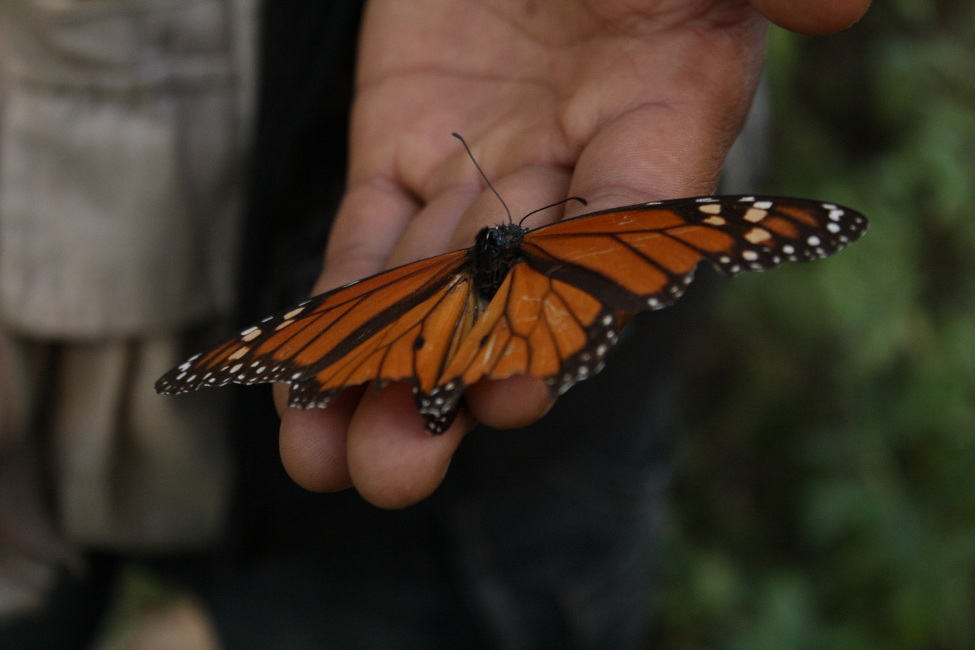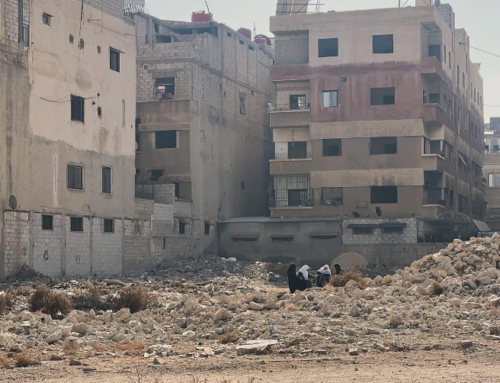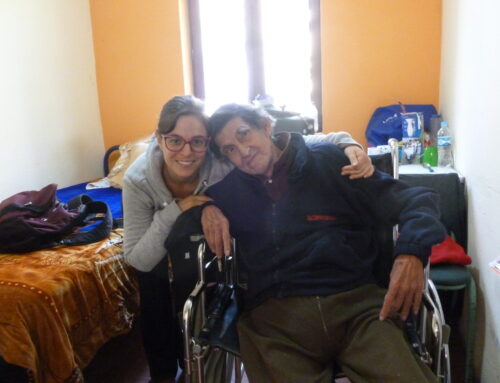
Monarch resting in oyamel tree in Mexico. Photo by author.
The migratory monarch butterfly, sometimes also called the “super butterfly” and the “Bambi of the insect world,” performs a majestic migration across North America (Canada, the United States, and Mexico). Each year, the insect travels up to 4,000 km to a warmer habitat when their host plant, a perennial “weed” known as milkweed, goes dormant from fall to spring. More than a host, milkweed can be seen as the monarch’s home or “oikos” (Greek root for “ecos,” meaning home). The plant provides food for the insect in all of its life stages. It grants them shelter as eggs and chrysalis, and later, by passing its toxic chemicals to the butterflies, milkweed even gives them a defense system. Monarchs’ reliance on milkweed is so strong that if the plant is present year-round, monarchs will stay in place all year instead of migrating. If milkweed goes dormant, monarchs go dormant as well.
It was by following both milkweed’s movement northward and its pattern of dormancy that monarchs developed their famous north-south-north migration about 20,000 years ago (Zhan et al. 2014). To escape harsh winters in the U.S. and Canada, they travel each fall to Mexico where they spend months hanging in packed clusters from specific trees called oyamel. This spectacular overwinter behavior has enchanted both the scientific community and the general public. The complex synchronized movements of milkweed and monarchs have also inspired my ethnographic practice. As a Mexican anthropologist living in the so-called “True North,” I move in the same directions as the monarch. Tracking its movements, I have developed a multi-species and multi-sited ethnography with the aim of “thinking-with” the monarch as “good to live-with” (Haraway 2016). Cultivating more-than-human relations is essential for advancing multispecies justice despite the tendency of academics to “think” in solo mode (Puig de la Bellacasa 2012, 203-205).
In this essay, I think-with monarchs to propose “ways of being with” that can support more just outcomes for North America’s migrating humans and nonhumans alike. Thinking-with monarchs, I argue, is an ethnographic practice mediated by a sense of care and flourishing. It invites us to challenge ethnography’s privileging of the “human” and, in doing so, to rethink the construction of “North America” through the lens of multispecies justice.
Convergent Migrations

Dead monarch picked by a local guide at the overwinter sites in Mexico. Photo by author.
Ruperto and I first met in a Latin store in downtown Leamington, Ontario. He was buying tortillas and I was looking for groceries for my next few weeks in the nearby Point Pelee National Park. I was drawn to Pelee for its iconic location for sighting butterflies at the beginning of their southbound migration and I was lucky enough to be living in the park’s research house where Frederick Urquhart, the supposed “hero” of monarch science (a term which should be taken with a grain of salt), worked in the early 1940s. I did not expect that fieldwork inside a nature park and about monarch conservation would turn into research with Mexican migrant workers. In fact, before crossing paths with Ruperto, I had no idea that there were Mexicans working in this area, much less about the poor conditions that Ruperto would relay to me in our second meeting. Although with different motivations and degrees of privilege (as I moved freely year-round with a student visa), these parallel movements— of the monarch, the migrant worker, and the ethnographer— have redirected my view of multispecies justice.
Two weeks later I met Ruperto downtown. Known as the Tomato Capital of Canada and the center of the country’s agribusiness, Leamington is a popular destination for Mexican temporary agricultural workers in Eastern Canada. When Ruperto arrived for our planned coffee, it was not difficult to spot him. He rode a bike—a key marker of being “from away” in this car-reliant region—and donned a cap bearing the logo of a popular Mexican football (soccer) team, “Las Chivas,” hinting that he was from central Mexico. Once seated, the first thing he shared was that he had been traveling to Ontario as a temporary agricultural worker for fifteen years. He continued, “If you come to Canada you are here to be commanded.” This he confided in a mildly triumphant tone, proud of not getting into work-related trouble all these years.
Leamington is part of the Corn Belt, an agribusiness region that cuts across the Canada-U.S. border. In the past, this zone was a prairie ecosystem, essential habitat for both milkweed and monarchs. Today, it is a monocrop landscape of genetically modified corn and soybean. The crops are sprayed with toxic substances that kill all plant-life except for corn, including the monarchs’ oikos, the milkweed. Across the Corn Belt’s two countries, but particularly in Canada, this agribusiness model relies on a temporary foreign worker program that pulls Mexican workers north. Once in Canada, these precarious workers often live in conditions of systematic abuse (Basok 2009; Binford 2013). After each season, they must return to Mexico because their stay is contingent on their temporary employment and there are few pathways to permanent residency or citizenship. Meanwhile, the North American Free Trade Agreement (NAFTA), has also pushed migrants north as imports of modified corn from the U.S. have undermined less subsidized and industrialized Mexican corn production (Fitting 2006).
This was the case for Ruperto. Back in Central Mexico, he dedicated himself to the production of corn, beans, and pumpkins before it became too difficult to “sustain the life of the peasant in Mexico.” Between joking about our experiences with the vicissitudes of Canadian weather, Rupert told me about his life as an “8 by 4” worker: eight months in Canada and four months in Mexico. Narrating both the complexities and attractiveness of this temporary worker model, he explained that all labor matters go through the capataz. The term capataz means “middleman” and comes from colonial Mexico’s forced labor model. In this Canadian region, the capataz are embodied by Mennonite men, Mexicans of European descent who travel freely across the continent within their binational communities. As Spanish and English speakers, the capataces are migrant workers’ authority figures. Ruperto showed me his hands, swollen from long days of work without rest. Despite the hardship he endures, he explained that he has never been reported to the boss by a capataz because he knows not to challenge their power. Nearing the end of our chat, I asked Ruperto if he knew about monarch butterflies and their fall trip to Mexico, but he had never visited Point Pelee. With only his bicycle to move around and no public transportation in the area, visiting a nature park to sightsee migrating butterflies was not part of his plans.
I invite the reader to picture those damaged hands—the product of fifteen years of return journeys along the same route as the monarch—and how they sustain the transnational agribusiness model of the Corn Belt, a business that displaces the milkweed and monarch from their original oikos, while attracting Mexican workers also displaced from their first “home.” These are convergent migrations of former peasants who are now supplying labor within an agribusiness model that damages ecologies locally and, to be ‘competitive’ under the NAFTA framework, damages the faraway livelihoods of smallholder farmers such as Ruperto.
This convergence of hardships is not radically new. Butterflies and racialized humans have suffered shared forms of displacement and violence within North American ecologies for centuries. These have formed the very bedrock of this region. But today, the violent construction and production of this North American territory is sustained through a system of putatively “free” trade across its three countries. While NAFTA has enabled deepening economic integration and the free movement of commodities, it contains specific people—racialized bodies—through border policies and walls. Tracking the shared histories of humans and monarchs shows how these contradictory geopolitics of containment and openness are detrimental to the region’s socioecologies.

A Latin neighborhood in Minneapolis, MN showing a monarch in the mural. Photo by author.
Relations of “thinking and knowing require care,” says feminist science and technology studies scholar Maria Puig (2012, 198). In my work with Mexican migrants in the U.S. and Canada, I often hear migrants’ reflections on the human right to move like the insect across two or more homes with the aim of flourishing (Ginn et al. 2014). As a Mexican ethnographer, engaging in conversations about Mexicans crossing national borders makes me uneasy. It gives me a subtle yet constant knot in my stomach. The knot is a body calling for cautious engagement. It warns of potential exposure (Cavell 2008) and vulnerability. I have learned to embrace this sense of exposure and appeal for caution by being precisely that—careful yet not detached. To embrace the labor of speaking-with and not about. I recognize my own vulnerability in the face of the difficult realities of my fieldwork, but mobilize this vulnerability to think-with monarchs and humans as a form of multispecies care.
The stories of migrating humans, often replete with tragedy and trauma, evoke the monarch’s way of life. Migrants’ journeys parallel the butterfly’s south-north migration as it has co-evolved with its milkweed host. Understanding that plants and butterflies move in the same direction as they do can at times provide strength and comfort to south-north migrants. Migrating people express a desire to travel across ecologies without border checks or papers, free from everyday forms of exclusion or policing. It bolsters their claims for the right to move across different ecologies that— like the milkweed to the monarch— offer them “homes.” Both confront the contradictions of a landscape that is at once highly unequal but also offers the promise of flourishing within and despite borders—a flourishing which feels more accessible through the messy muddling of knotted humans and monarchs. Mexican Americans refer to this knotted existence between butterflies and human migratory routes as a “unity.” I find this claim to unity encouraging. They describe not a coherent unity, but more of a “cobbling together” as Donna Haraway and Maria Puig so aptly put it. One that shows that we need many different but equally healthy “houses.”
Thinking-with as conversing-with
Thinking-with more than humans as ethnographic practice requires being in tune with the complexity of this unity—a practice of meaningfully knowing, of conversing, in an ecology of connected knowledges (Najmanovich 2021). It is more like conversing-with (conversar in Spanish means “going around in company”): going around with attention and care to both the humans and other entities of fieldwork.
This requires commitments that go beyond traditional understandings of academic work. I speak of implication. I speak of reciprocity with those who share dreams and nightmares in the ethnographic context. I speak of being more like milkweed, providing oikos/ecos. Co-thinking with the monarch in this way creates multispecies justice.
Acknowledgements
I thank my interlocutors in the three countries who have shared with me their stories of butterflies and wishes for a better North America. I appreciate the comments of Dr. Marcela Magaña in reorienting my work towards germinative feminist ecologies. Professors Donna Haraway and Denise Najmanovich have been key in inspiring me to write with greater multispecies commitment. I appreciate their generous guidance.
References
Basok, Tanya. 2009. Tortillas and Tomatoes Transmigrant Mexican Harvesters in Canada. Montreal: McGill-Queen’s University Press. http://site.ebrary.com/id/10119956.
Binford, Leigh. 2013. Tomorrow We’re All Going to the Harvest: Temporary Foreign Worker Programs and Neoliberal Political Economy. 1. ed. Joe R. and Teresa Lozano Long Series in Latin American and Latino Art and Culture. Austin, Tex: Univ. of Texas Press.
Cavell, Stanley, ed. 2008. Philosophy and Animal Life. New York, NY: Columbia Univ. Press.
Fitting, Elizabeth. 2006. “Importing Corn, Exporting Labor: The Neoliberal Corn Regime, GMOs, and the Erosion of Mexican Biodiversity.” Agriculture and Human Values 23 (1): 15–26. https://doi.org/10.1007/s10460-004-5862-y.
Ginn, Franklin, Uli Beisel, and Maan Barua. 2014. “Flourishing with Awkward Creatures: Togetherness, Vulnerability, Killing.” Environmental Humanities 4 (1): 113–23. https://doi.org/10.1215/22011919-3614953.
Haraway, Donna Jeanne. 2016. Manifestly Haraway. Posthumanities 37. Minneapolis: University of Minnesota Press.
Najmanovich, Denise. 2021. “Cuidadanía: de la intervención a conversación (o el discreto encanto del pensar vital).” Conferencia inaugural del Congreso 2021 de la APCVC Córdoba, March 2.
Puig de la Bellacasa, María. 2012. “‘Nothing Comes Without Its World’: Thinking with Care.” The Sociological Review 60 (2): 197–216. https://doi.org/10.1111/j.1467-954X.2012.02070.x.
Zhan, Shuai, Wei Zhang, Kristjan Niitepõld, Jeremy Hsu, Juan Fernández Haeger, Myron P. Zalucki, Sonia Altizer, Jacobus C. de Roode, Steven M. Reppert, and Marcus R. Kronforst. 2014. “The Genetics of Monarch Butterfly Migration and Warning Colouration.” Nature 514 (7522): 317–21. https://doi.org/10.1038/nature13812.
Columba Gonzalez-Duarte is an Assistant Professor at Mount Saint Vincent University. She explores multispecies relations between monarchs, labour migration, and Indigenous communities within North America.
Cite As: Gonzalez-Duarte, Columba. 2022. Borders of Care: Ethnography with the Monarch Butterfly, American Ethnologist website, 18 May 2022, [https://americanethnologist.org/features/reflections/borders-of-care-ethnography-with-the-monarch-butterfly]
This piece was edited by American Ethnological Society Digital Content Editor Katie Kilroy-Marac (katie.kilroy.marac@utoronto.ca).




